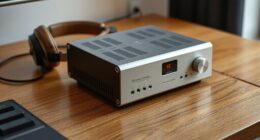Thread networking is a secure, energy-efficient mesh protocol designed for smart home devices. It allows your devices to communicate directly with neighbors, eliminating the need for a central hub and making your network reliable and scalable. Built on IPv6, it supports compatibility with various platforms and promotes easy expansion. Plus, it conserves battery life while protecting your data. Keep exploring to discover how this technology can enhance your smart home experience.
Key Takeaways
- Thread is a low-power, mesh networking protocol designed for secure and reliable smart home device communication.
- It uses IPv6, enabling easy integration with existing internet infrastructure and IoT devices.
- The protocol supports energy-efficient operation, allowing devices to sleep and conserve battery life.
- Devices connect directly with neighbors, creating a scalable, self-healing network without a central hub.
- Thread prioritizes security and privacy, protecting data through encryption and device authentication.

Have you ever wondered how smart home devices communicate seamlessly with each other? It’s a fascinating process that relies on robust networking protocols designed for efficiency and security. When you’re setting up a smart home, understanding how these devices connect and stay protected is essential. One key aspect is IoT device security, which ensures your devices aren’t vulnerable to hacking or unauthorized access. Thread networking plays a significant role here because it offers a secure environment by encrypting data and incorporating safety features directly into the protocol. Unlike some older systems, Thread uses device authentication and secure communication channels, so your smart home data remains private and protected from malicious interference.
Thread ensures secure, encrypted communication between smart home devices, protecting your data from unauthorized access.
Another critical benefit of Thread is its energy-efficient protocols, which are especially important for battery-powered devices like sensors, door locks, or thermostats. These protocols are designed to consume minimal power while maintaining reliable, real-time communication. You won’t have to worry about frequently replacing batteries or experiencing connectivity issues due to energy drain. Instead, Thread allows devices to sleep when they’re not actively transmitting data, waking only when necessary. This efficiency not only prolongs battery life but also reduces your overall energy consumption, making your smart home more environmentally friendly and cost-effective.
Getting started with Thread means understanding how it forms a mesh network. Instead of relying on a central hub or router, each device acts as a node, communicating directly with neighboring devices. This decentralized setup enhances reliability because if one device goes offline, the others can reroute data seamlessly through alternative paths. You gain a network that’s resilient and capable of self-healing, which is crucial for maintaining consistent smart home operations. Plus, because Thread is built on IPv6, it can easily integrate with existing internet infrastructure, ensuring compatibility with other smart home platforms and IoT devices.
Understanding production quantity variance security and energy efficiency are baked into the core of Thread’s design, making it an ideal choice for beginners who want a reliable, safe, and eco-friendly networking solution. As you set up your smart home, knowing that your devices are communicating through a protocol that prioritizes IoT device security will give you peace of mind. Meanwhile, energy-efficient protocols mean your devices can run longer on less power, reducing maintenance and energy bills. By understanding these foundational elements, you can confidently expand your smart home ecosystem, knowing that Thread provides a scalable, secure, and sustainable foundation for your connected devices.
Frequently Asked Questions
How Does Thread Compare to Other Iot Networking Protocols?
You’ll find that Thread outperforms many IoT protocols thanks to its mesh topology, which allows devices to connect directly and communicate reliably. It’s designed for low power, so your devices conserve energy while staying connected. Unlike some protocols that rely on central hubs, Thread creates a resilient network where devices can route data efficiently, making it ideal for smart homes and other IoT applications requiring stability and longevity.
What Are the Security Features of Thread Networks?
You benefit from Thread networks’ strong security features like security encryption and device authentication. These protocols guarantee your devices communicate securely, preventing unauthorized access and data breaches. Thread automatically encrypts data transmitted across the network, safeguarding your information. Additionally, it verifies device identities through robust authentication methods, so you can trust that only authorized devices connect to your network, keeping your smart home safe and secure.
Can Thread Networks Scale for Large Smart Home Systems?
Like a mighty river flowing endlessly, Thread networks can scale for large smart home systems, but you’ll face some scalability challenges. As you push for network expansion, managing increased device density and maintaining performance becomes trickier. While Thread’s mesh architecture helps, ensuring reliable communication across a vast array of devices requires careful planning. With proper design, you can overcome these hurdles and enjoy seamless connectivity as your smart home grows.
What Devices Are Compatible With Thread Technology?
You’ll find that many smart home devices are compatible with Thread technology, including smart thermostats, light bulbs, and sensors. To confirm compatibility, check device requirements like supporting the Thread protocol and having a compatible border router. Popular brands such as Apple, Google, and Amazon offer Thread-enabled products. Make sure to verify each device’s specifications to guarantee seamless integration into your Thread-based mesh network for reliable, low-power connectivity.
How Do I Troubleshoot Thread Network Connectivity Issues?
Ever wonder how to fix your Thread network’s connectivity? First, use diagnostics tools to identify where the problem lies. Check for signal interference from other wireless devices or obstacles blocking the signal. Restart your devices and verify firmware is up to date. If issues persist, reset your network and re-pair your devices carefully. Staying proactive helps maintain a smooth, reliable Thread network connection.
Conclusion
By now, you should see that Thread networking is a game-changer for smart homes. Its low power, reliability, and easy setup make it a solid choice. Don’t put all your eggs in one basket—exploring Thread opens new doors for connected devices. Keep learning and experimenting, because the more you understand, the better you’ll harness its potential. Remember, Rome wasn’t built in a day, so take your time and enjoy the journey into smart networking.









